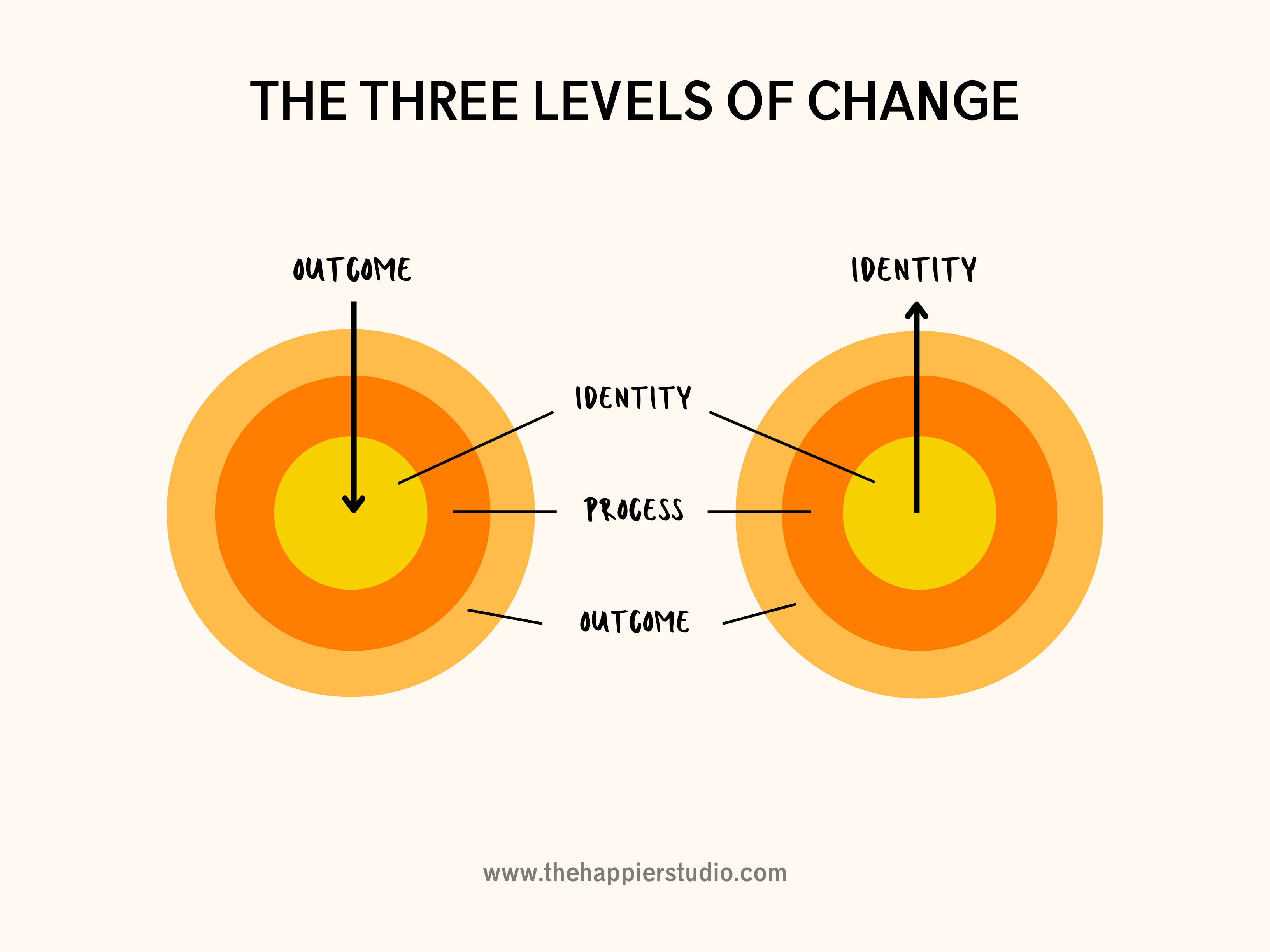February 16, 2025 | #27 | read on The Happier Studio | Free Version
Welcome to The Happier Newsletter, a weekly newsletter where I provide actionable ideas to help you build a happier, healthier, and more meaningful life.
What’s On Today
- You Don’t Find Yourself—You Create Yourself
- The Real Secret to Setting Goals That Stick
- 3 Things I’m Grateful For This Week
You Don’t Find Yourself—You Create Yourself

We’ve all heard it: “I need to find myself.”
Sounds deep. Profound. Like your real identity is out there somewhere, just waiting to be uncovered—maybe on a remote retreat, in a career change, or during a backpacking trip.
But here’s the truth: You don’t find yourself. You create yourself.
Your identity isn’t buried under some grand revelation. It’s built—brick by brick—through your daily choices, habits, and actions. And science backs this up: every decision you make rewires your brain, reinforcing who you’re becoming.
So instead of waiting for clarity to magically appear, follow these two steps to start creating the person you want to be.
1. Know Your Values—Or Drift Through Life
Your values are your internal compass. If you don’t define them, you’ll end up living by someone else’s—often without even realising it.
That’s exactly what happens to most people. They never stop to ask what they actually want out of life. Instead, they follow the default script: Go to uni. Get a stable job. Climb the corporate ladder. Buy a house. Settle down. Retire.
It’s not that any of these things are bad—but if you never question them, if you never ask yourself what you truly want, you might wake up one day wondering: How did I end up here?
Research on Self-Determination Theory (aka, what actually drives human motivation) shows that people who align their lives with their intrinsic values—like connection, creativity, or contribution—are happier, more fulfilled, and feel a deeper sense of purpose.
But this is only true for those who know what their values are. And too many people never take the time to define them.
So ask yourself:
- What actually matters to me?
- What kind of impact do I want to make?
- When have I felt the most fulfilled or proud of myself?
- What do I want to be remembered for?
- What activities make me feel energised and alive?
Once you’ve written down your answers to these questions, look for patterns. What values keep showing up? What themes connect your responses?
Think about the core values that link to your answers and write down 3–5 that truly define what matters most to you.
Then, for each core value, write down what it actually means to you. Don’t just list vague words—clarify how each value shows up in your life and why it matters. This step is crucial because a value without definition is just an idea, not a guide for action.
For example, one of my core values is freedom.
But what does freedom actually mean? For some, it means financial independence. For others, it means the ability to travel or express themselves freely.
For me, freedom means having control over my time, my energy, and my decisions. It means not being tied to a job I don’t love, having the flexibility to work on meaningful projects, and spending time with the people who matter most.
See the difference? Writing down a vague word like freedom won’t guide your life. But defining it will.
👉 Action Step: Pick one of your values and write down exactly what it means to you. The clearer you get, the easier it is to make decisions that align with it.
2. Who Do You Want to Become?
Most people have a vague idea of who they want to be—but never define it clearly enough to take action. They imagine a better version of themselves but don’t take the next step: turning that vision into a concrete plan.
That’s where Mental Contrasting comes in. Research by Gabriele Oettingen shows that just visualising success isn’t enough—you need to pair that vision with an honest look at the real-world obstacles in your way.
Why? Because when you only picture the end result (being fit, productive, successful), your brain gets a small dopamine hit—tricking you into feeling like you’ve already made progress. This makes you less likely to take action.
But when you contrast your ideal future with the challenges you’ll face along the way, something shifts. You stop daydreaming and start problem-solving.
For example:
- Vague vision: “I want to be someone who reads more.”
- Mental contrasting: “I want to be a reader, but I keep scrolling on my phone at night instead of picking up a book. I need to set a rule: 30 minutes of reading before bed, phone in another room.”
The second version forces you to confront why you’re not already the person you want to be—and what you can do about it.
So ask yourself:
- What habits define the person I want to be? (Do they read daily? Train consistently?)
- What skills have they mastered? (Public speaking? Deep work? Resilience?)
- How do they handle challenges? (With stress? Or with curiosity?)
For example, my ideal self trains like an athlete. But just saying “I want to train like an athlete” isn’t enough. I need to define it.
- It means following a structured training plan, not just working out randomly.
- It means fuelling my body like an athlete, not skipping meals or eating whatever’s convenient.
- It means showing up even when I don’t feel like it—because consistency beats motivation every time.
Right now, I’m nowhere near my ideal self—but that’s exactly why this matters. The gap between who I am today and who I want to become isn’t a reason to quit—it’s proof that there’s work to do. And the only way to close that gap is to stop waiting to become that person—and start acting like them today.
👉 Action Step: Pick one habit your future self has. Define exactly what it looks like—then start doing it today.
To sum up. Your values set the foundation. Your ideal self gives you direction. Together, they create the blueprint for who you’re becoming.
- Without clear values? You’re lost—chasing things that don’t actually matter to you.
- Without a defined vision? You’re stuck—knowing what’s important but not actually living it.
If you say you value growth but never challenge yourself, you’re out of alignment. If you claim to prioritise health but your actions don’t reflect it, you’re reinforcing an identity that contradicts what you say you care about.
At the end of the day, your identity isn’t something you find—it’s something you build, one choice at a time.
The Real Secret to Setting Goals That Stick

If you really want to transform, you need to shift how you think about goals.
Most people set goals like this:
- “I want to lose 10kg.”
- “I want to write a book.”
- “I want to wake up early.”
And that’s why most people fail. They focus on the outcome instead of their identity.
James Clear breaks down the 3 layers of behaviour change:
- Outcome-based goals → What you want (lose weight, write a book).
- Process-based goals → What you do (work out, write daily).
- Identity-based goals → Who you become (“I am someone who prioritises health. I am a writer.”).
Identity-based goals stick because they shift your self-perception.
If you want to lose weight, stop saying “I need to hit the gym.” Start saying “I’m becoming the kind of person who moves their body every day.”
If you want to write, stop saying “I need to finish my book.” Start saying “I am a writer, and I write every day.”
👉 Action Step: Rewrite one of your current goals as an identity-based goal. Then prove it with one small action today.
3 Things I’m Grateful For This Week
- Celebrating my two-year anniversary with my wife 🥂
- The freedom to travel and explore new places ✈️
- Quality time with friends in Brisbane ☀️
What are you grateful for this week?
